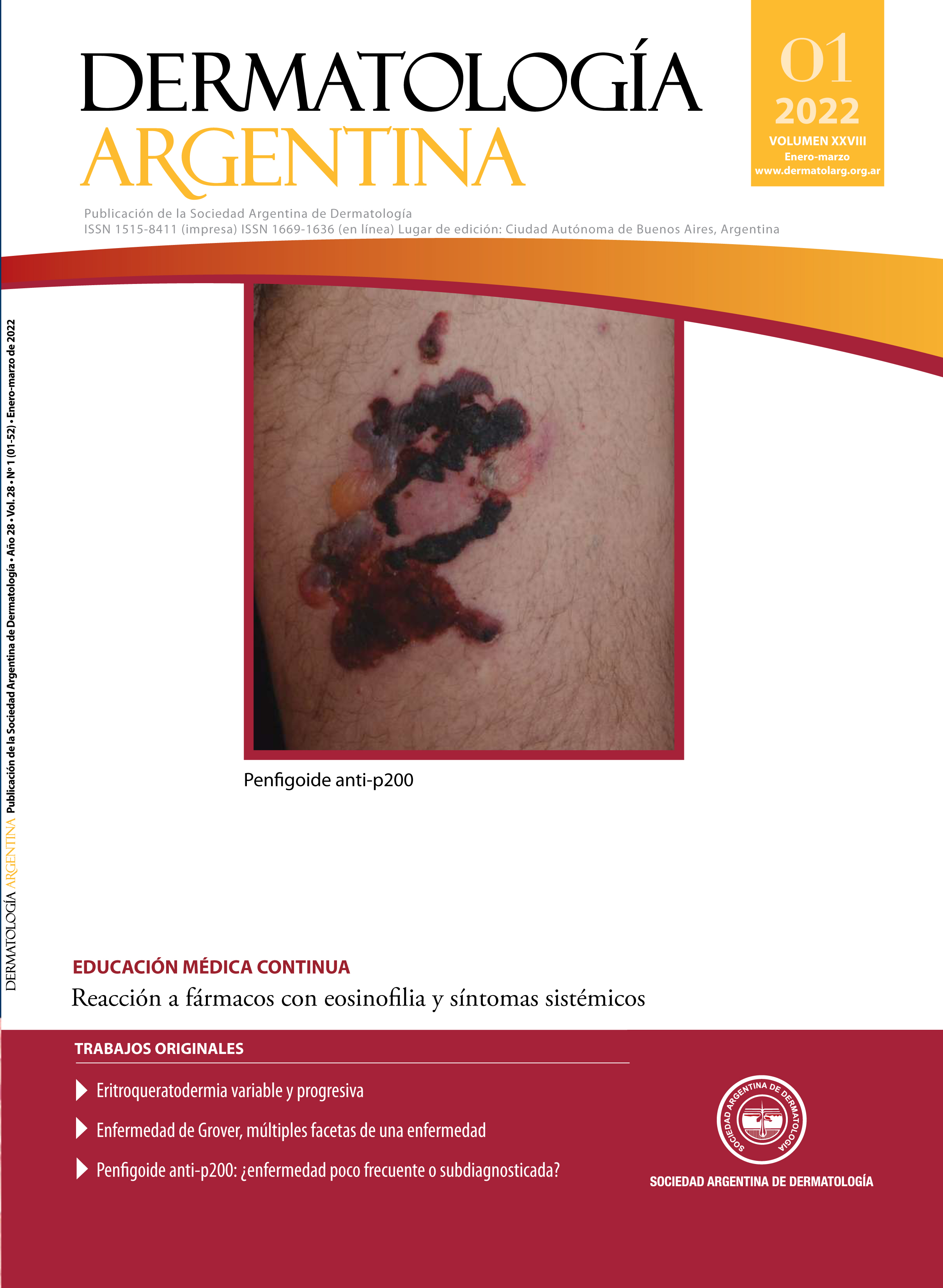Erythrokeratodermia variabilis et progressiva: report of a case series with variants in two genes
DOI:
https://doi.org/10.47196/da.v28i1.2226Keywords:
erythrokeratodermia variabilis et progressiva, connexin 30.3, GJB4, TRPM4Abstract
Cryoglobulinemia erythrokeratodermia variabilis et progressiva is a genodermatosis in most cases that is inherited in an autosomal dominant manner and has variable expressivity. It is mainly produced by pathogenic variants in the GJB3, GJB4 and GJA1 genes. These genes encode the proteins connexin 31, connexin 30.3, and connexin 43, respectively. In addition, cases associated with pathogenic variants in the KDSR, KRT83, TRPM4 and PERP genes have been published to a lesser extent.
Clinically, it is characterized by fixed or migratory erythematous and hyperkeratotic plaques on the skin. In 50% of cases it is accompanied by palmoplantar keratoderma.
The interest of the communication is to present a family with a diagnosis of erythrokeratodermia variabilis et progressiva. The molecular study of one of the patients revealed two variants that may be associated with the disease, one of them in the GJB4 gene not reported in the literature and the other recently published in the TRMP4 gene.
References
I. van Steensel MA, Oranje AP, van der Schroeff JG, Wagner A, et ál. The missense mutation G12D in connexin 30.3 can cause both erythrokeratodermia variabilis of Mendes da Costa and progressive symmetric erythrokeratodermia of Gottron. Am J Med Genet A. 2009;149A:657-661.
II. Mendes da Costa. Erythro-et keratodermia variabilis in a mother and daughter. Acta Derm Venerol. 1925;6:255-261.
III. Barzallo M, Legña D, Legña M. Eritroqueratodermia variabilis. Reporte de un caso. Dermatol Pediatr Lat. 2006;4:217-219.
IV. Hernández-Velasco FA, Santacoloma-Osorio G. Eritroqueratodermia variabilis. Rev Asoc Colomb Dermatol Cir Dematol. 2006;14:392-394.
V. Wang H, Xu Z, Lee BH, Vu S, et ál. Gain-of-function mutations in TRPM4 activation gate cause progressive symmetric erythrokeratodermia. J Invest Dermatol. 2019;139:1089-1097.
VI. Guaraldi B de M, Jaime TJ, Guaraldi R de M, Melo DF, et ál. Progressive symmetrical erythrokeratodermia. Case report. AnBras Dermatol. 2013;88:109-112.
VII. Duchatelet S, Hovnanian A. Erythrokeratodermia variabilis et progressiva allelic to oculo-dento-digital dysplasia. J Invest Dermatol. 2015;135:1475-1478.
VIII. Boyden LM, Craiglow BG, Zhou J, Hu R, et ál. Dominant De novo mutations in GJA1 cause erythrokeratodermia variabilis et progressiva, without features of oculodentodigital dysplasia. J Invest Dermatol. 2015;135:1540-1547.
IX. Verma SB, Wollina U. Progressive symmetric erythrokeratodermia with delayed intellectual milestones and convulsions. Indian Dermatol Online J. 2012;3:54-56.
X. Morales-Barrera ME, Marín-Hernández E, Orellana-Arauco AR, Villagómez-Llanos E, et ál. Eritroqueratodermia simétrica y progresiva. Rev Cent Dermatol Pascua. 2011;20:59-62.
XI. Cano MM, Martínez C, Ponssa G, Consigli J, et ál. Eritroqueratodermia simétrica progresiva: seguimiento prolongado de un paciente. Dermatol Pediatr Latinoam. 2012;10:72-74.
Downloads
Published
Issue
Section
License
Copyright (c) 2022 Dermatología Argentina

This work is licensed under a Creative Commons Attribution-NonCommercial-NoDerivatives 4.0 International License.
El/los autor/es tranfieren todos los derechos de autor del manuscrito arriba mencionado a Dermatología Argentina en el caso de que el trabajo sea publicado. El/los autor/es declaran que el artículo es original, que no infringe ningún derecho de propiedad intelectual u otros derechos de terceros, que no se encuentra bajo consideración de otra revista y que no ha sido previamente publicado.
Le solicitamos haga click aquí para imprimir, firmar y enviar por correo postal la transferencia de los derechos de autor













